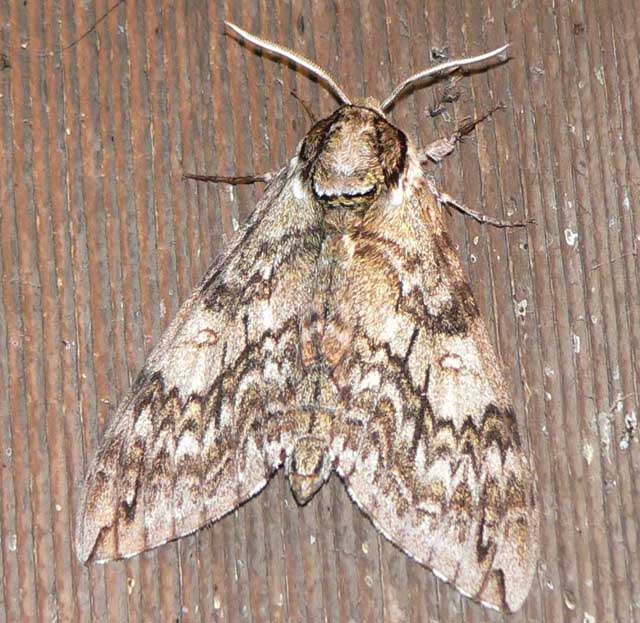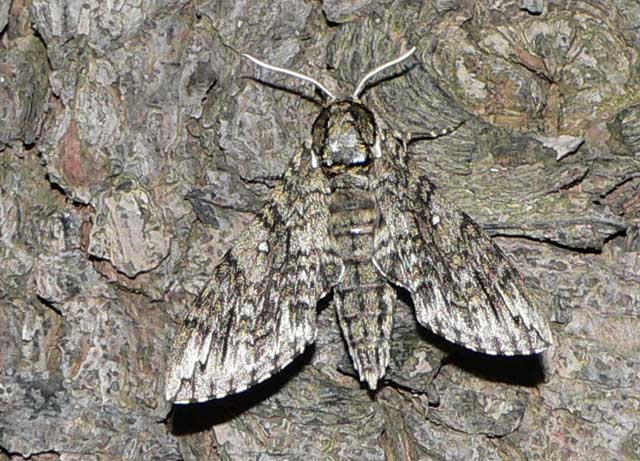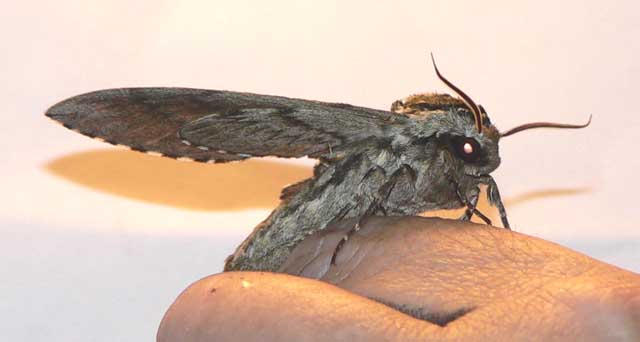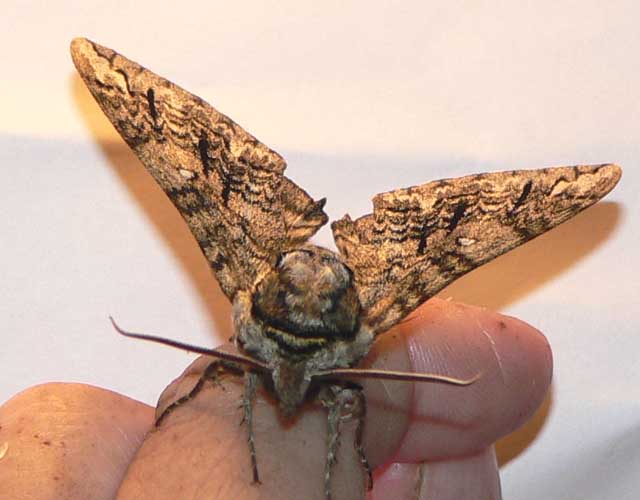Chautauqua County, New York
Sphingidae
Ceratomia undulosa, Chautauqua County, July 11, 2007, courtesy of Beth Boyle.

Ceratomia undulosa, Chautauqua County, July 12, 2008, courtesy of Beth Boyle.

Ceratomia undulosa, Chautauqua County, July 11, 2007, courtesy of Beth Boyle.

Ceratomia undulosa, Chautauqua County, July 12, 2008, courtesy of Beth Boyle.
Almost one year later to the day, Beth encountered
another Ceratomia undulosa at her porch light. It will be
interesting to see what happens the second week in July, 2009.
Warmth and photo period have much to do with the emergence
patterns of these moths.
This specimen (2008) is smaller than the one she encountered in 2007,
and the markings are not as contrasting. Such is the natural
variation within the species.
The white-black-gold-black band across the juncture of the thorax
and abdomen is quite consistent, however, within this species.
On June 29, 2009, Beth encountered another Ceratomia undulosa
in her yard. On July 11, 2009, there were three specimens in her yard, so it appears the peak flight time in her area is probably early to mid July.
There may or may not be a second brood.
On July 19-20, 2009, Beth Boyle confirms presence of Pachysphinx modesta with an electronic image of a slightly worn specimen.
On July 15, 2011, Beth Boyle photographed a slightly worn Ceratomia undulosa. She indicates she did not see any in 2010.
Forty-six Sphingidae species are listed for New York on the U.S.G.S. website. Not all of the species are reported or anticipated in Chatauqua County (twenty-five are reported on U.S.G.S.).
It is hoped that this checklist, with the thumbnails and notes, will help you quickly identify the moths you are likely to encounter.
A "WO" after the species name indicates that I have no confirmed reports of this species in Chautauqua County, but I (William Oehlke) expect that this moth is present or might be present. A "USGS" indicates the moth is reported on the USGS website and/or in Lepidoptera of North America, #1. Distribution of Silkmoths (Saturniidae) and Hawkmoths (Sphingidae) of Eastern North America, an excellent little booklet available through Paul Opler.
This page is inspired by and dedicated to Beth Boyle
who sent me the Ceratomia undulosa images, top of page and
immediately below.
Beth writes, "We had this big moth land on the door sill at 11:00 at
night, July 11th, 2007. We put it on the big spruce tree by our door to
take a picture and it seemed happy to be picked up so we took a few
shots on my hand. Can you tell what this lovely creature is? We live
in Western, NY near the PA line and 9 miles inland from Lake Erie.
Its eyes glowed red when the light hit them. It was very heavy
bodied too."

Ceratomia undulosa, Chautauqua County, July 11, 2007, courtesy of Beth Boyle.

Ceratomia undulosa, Chautauqua County, July 12, 2008, courtesy of Beth Boyle.
Please help me develop this list with improved, documented accuracy by sending sightings (species, date, location), preferably with an electronic image, via email to Bill Oehlke.
Sphinginae subfamily
July 11 (3), 2009, July 15, 2011; Beth Boyle.
Smerinthini Tribe:
Macroglossinae subfamilyDilophonotini tribe:
See Hemaris comparison to help distinguish the next three species.
Philampelini tribe:
Macroglossini tribe:
|
Enjoy some of nature's wonderments, giant silk moth cocoons. These cocoons are for sale winter and fall. Beautiful Saturniidae moths will emerge the following spring and summer. Read Actias luna rearing article. Additional online help available.
Eggs of many North American species are offered during the spring and summer. Occasionally summer Actias luna and summer Antheraea polyphemus cocoons are available. Shipping to US destinations is done from with in the US.
Use your browser "Back" button to return to the previous page.
This page is brought to you by Bill Oehlke and the WLSS. Pages are on space rented from Bizland. If you would like to become a "Patron of the Sphingidae Site", contact Bill.
Please send sightings/images to Bill. I will do my best to respond to requests for identification help.
 Show appreciation for this site by clicking on flashing butterfly to the left. The link will take you to a page with links to many insect sites. |